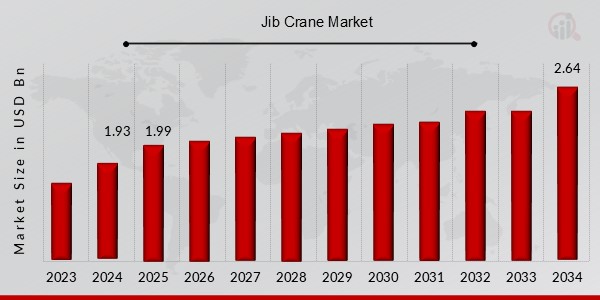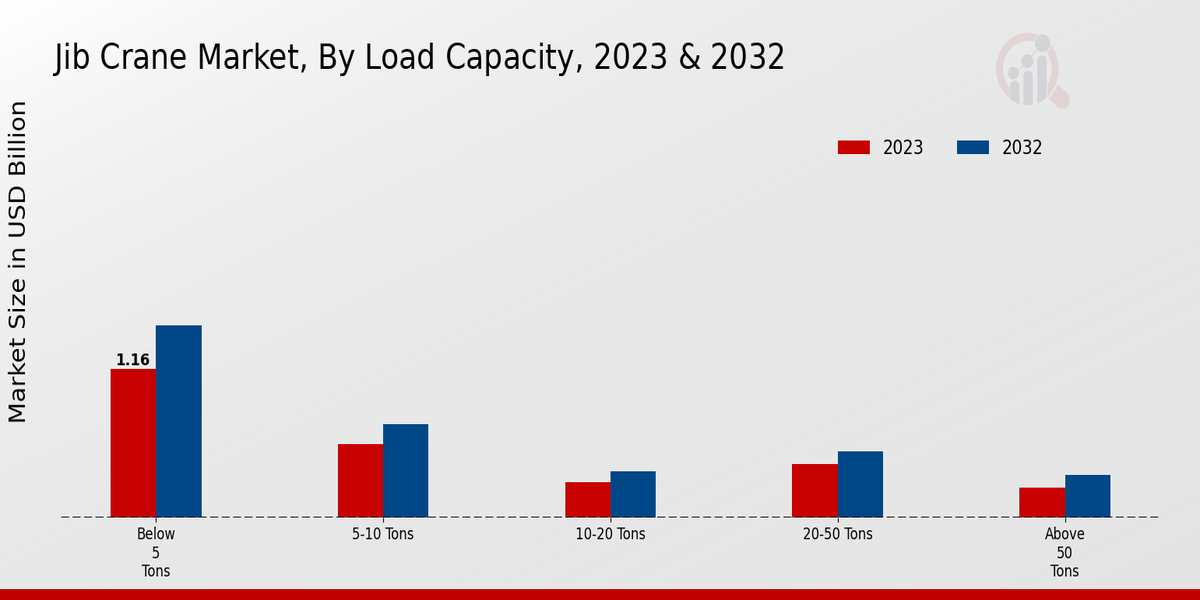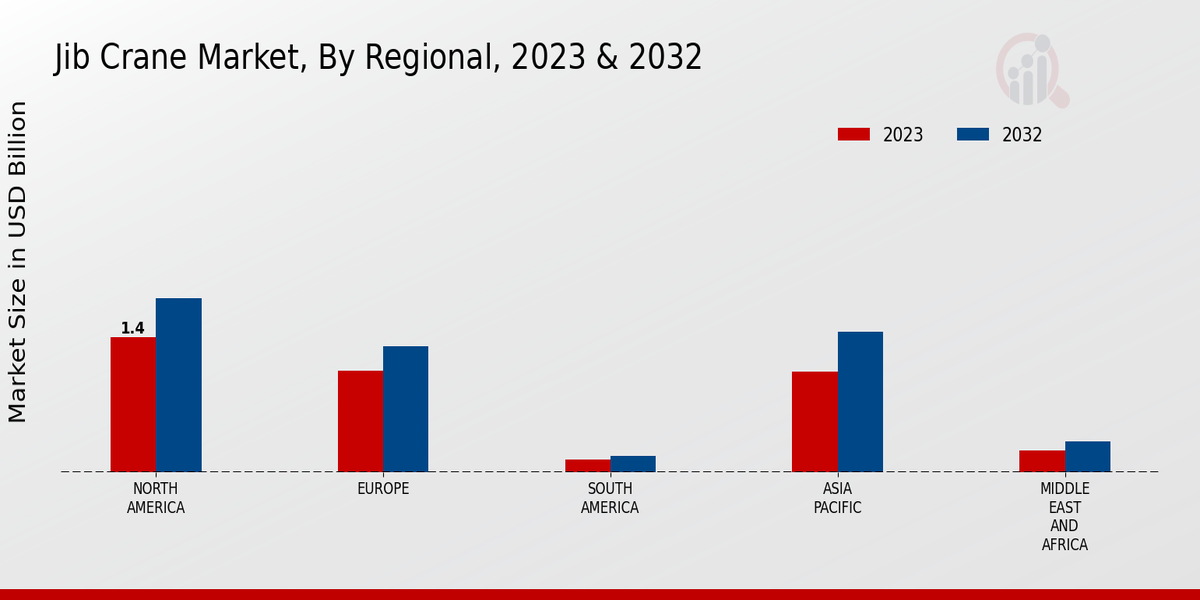Global Jib Crane Market Overview
The Jib Crane Market Size was estimated at 1.93 (USD Billion) in 2024. The Jib Crane Industry is expected to grow from 1.99 (USD Billion) in 2025 to 2.64 (USD Billion) by 2034. The Jib Crane Market CAGR (growth rate) is expected to be around 3.2% during the forecast period (2025 - 2034).
Key Jib Crane Market Trends Highlighted
The jib crane market is witnessing a surge in demand due to their versatility and ease of use in various industrial and commercial applications. The rising adoption of automated systems and the need for efficient material handling solutions are driving the market growth. Additionally, the increasing focus on workplace safety and ergonomics is boosting the demand for jib cranes as they provide precise and controlled lifting operations.
The market is also driven by the growing need for flexibility and mobility in production and manufacturing environments. Jib cranes offer the advantage of being easily installed and relocated, making them suitable for temporary or changing production requirements. Furthermore, technological advancements such as the integration of sensors and IoT connectivity are enhancing the capabilities of jib cranes, enabling real-time monitoring and remote control.
Recent trends in the jib crane market include the increasing adoption of customized solutions tailored to specific industry needs. Manufacturers are focusing on providing jib cranes with customized capacities, reach, and configurations to meet the unique lifting requirements of various applications. Another notable trend is the growing popularity of electric jib cranes, which offer energy efficiency, reduced maintenance costs, and quieter operation.

Source Primary Research, Secondary Research, MRFR Database and Analyst Review
Jib Crane Market Drivers
Increasing Demand for Material Handling in Industrial Applications
The emergence of the manufacturing industry has led to a growing need for efficient material handling solutions, with jib cranes being one of the most widely used implementations in a variety of industrial sectors. These include automotive, aerospace, shipbuilding, heavy machinery manufacturing, and others. The main reasons for such popularity are the cranes’ ability to lift and move even the heaviest loads with exceptional precision and minimal time expenditures. As the industry also features developing automation and robotics, jib cranes can also be seamlessly integrated into such systems for additional efficiency.
Expansion of Construction and Infrastructure Projects
A blooming construction industry has significant prospects for the Jib Crane Market Industry. Jib cranes are known to be an essential part of the construction site, where they are utilized for lifting and positioning of materials, equipment, and even personnel. In addition, they are sufficiently compact to be effective in confined spaces, as well as capable of reaching heights inaccessible to other types of cranes. Today, the rapid pace of infrastructure development projects contributes to the increasing demand for jib cranes around the world.
Technological Advancements and Innovation
Technological development has become one of the main factors influencing the Jib Crane Market Industry. Manufacturers invest more and more funds in research and development to make jib cranes more efficient and capable. Modern jib cranes use lighter and more advanced materials in their construction. In addition to this, control systems and the possibility of remote operation and monitoring have also greatly improved. Moreover, modern sensors and the Internet of Things allow us to continuously monitor the crane and predict different technical malfunctions. All this improves safety and helps to better utilize the crane machine.
Jib Crane Market Segment Insights
Jib Crane Market Load Capacity Insights
The Jib Crane Market is segmented by load capacity as below 5 tons, 5-10 tons, 10-20 tons, 20-50 tons, and above 50 tons. Among these segments, the 5-10 tons segment has the largest market share. This segment is expected to grow at a CAGR of 3.5% from 2024 to 2032, which is the second slowest among all the segments. The growth rate of this segment is relatively slow due to the saturation in the market. Overall, the Jib Crane Market is expected to grow at a CAGR of 3.4% from 2024 to 2032. Specifically, the below 5 tons segment is expected to grow at a CAGR of 3.2% during the forecast period.Growth in this segment is driven by the increasing demand for small jib cranes for use in confined spaces. The 10-20 tons segment is expected to grow at a CAGR of 3.4% during the forecast period. Growth in this segment is driven by the increasing demand for jib cranes for use in medium-sized applications. The 20-50 tons segment is expected to grow at a CAGR of 3.6% during the forecast period. Growth in this segment is driven by the increasing demand for jib cranes for use in heavy-duty applications. The above 50 tons segment is expected to grow at a CAGR of 3.8% during the forecast period. Growth in this segment is driven by the increasing demand for jib cranes for use in very heavy-duty applications.

Source Primary Research, Secondary Research, MRFR Database and Analyst Review
Jib Crane Market Type Insights
Jib Cranes Market by Type Wall-Mounted Jib Cranes Floor-Mounted Jib Cranes Portable Jib Cranes Articulating Jib Cranes Among the aforementioned types of jib cranes, the Wall-Mounted Jib Cranes segment accounted for the highest share in 2023, and it is anticipated to be dominant over the estimated timeframe. Contributing towards the higher share of the segment, the increasing requirement of these cranes in various industrial applications, such as manufacturing, warehousing, and construction, aids in attributing to this dominance. The Floor-Mounted Jib Cranes segment is anticipated to exhibit a moderate growth rate in the coming years as they offer a higher load-bearing capacity to the cranes, leading to the handling of heavy loads. Portable Jib Cranes are gaining momentum, attributed to the ease of installation and portability. The Articulating Jib Cranes segment is anticipated to witness a promising growth rate due to its flexibility and operation capability in confined spaces.
Jib Crane Market Control System Insights
The Jib Crane Market segmentation by Control System is growing at a CAGR during the forecast period. The various types of Control Systems include Manual Control, Electric Control, Pneumatic Control, and Hydraulic Control. The Electric Control segment holds a prominent share of the market, attributed to the growing demand for automated and efficient lifting solutions. It provides precise and responsive control over the crane's movements, enabling operators to handle loads accurately and safely.
The manual Control segment is expected to witness steady growth due to its cost-effectiveness and suitability for smaller cranes. The pneumatic Control segment offers advantages such as compactness, low maintenance, and adaptability to harsh environments, making it a preferred choice for certain industrial applications. The hydraulic Control segment is gaining traction in heavy-duty lifting applications, as it provides high power and controllability, ensuring smooth and precise crane operations. The rising adoption of Jib Cranes across various industries, including manufacturing, construction, and logistics, is driving the growth of the Control System segment.
Jib Crane Market Lifting Mechanism Insights
The Lifting Mechanism segment of the Jib Crane Market is anticipated to witness significant growth in the coming years. The market is segmented into two primary categories Chain Hoists and Wire Rope Hoists. Chain Hoists are expected to hold a larger market share due to their compact size and affordability. They are commonly used in applications where precision lifting is required, such as in assembly lines and warehouses. On the other hand, Wire Rope Hoists are more suitable for heavy-duty applications, such as lifting heavy machinery or materials in the construction and mining industries.The Jib Crane Market revenue for Lifting Mechanisms is projected to grow at a CAGR of 3.4% from 2023 to reach USD 1.2 billion by 2032. This growth is attributed to the increasing demand for jib cranes in various industries, including manufacturing, construction, and automotive.
Jib Crane Market Application Insights
The application segment plays a crucial role in shaping the Jib Crane Market. Manufacturing has the largest share of the market, driven by the need for efficient material handling in production facilities. Construction is another significant segment, with a growing demand for jib cranes in infrastructure projects and commercial buildings. Warehouse Distribution centers rely heavily on jib cranes for efficient storage and retrieval of goods. Automotive, Mining Exploration industries also contribute to the market growth due to their specific needs for precise and heavy-duty lifting solutions. Overall, the diverse application segments drive the demand for jib cranes, influencing the market growth and segmentation dynamics.
Jib Crane Market Regional Insights
The regional market of Jib Crane Market is expected to grow significantly in the coming years. In 2023, North America held the largest market share, accounting for over 35% of the revenue. Europe followed with a market share of around 30%, while APAC accounted for approximately 25%.
South America and MEA are expected to witness steady growth in the coming years. The growth in North America is driven by factors such as the increasing demand for jib cranes in the manufacturing, construction, and logistics industries.
Europe is also expected to witness significant growth due to the rising demand for jib cranes in the automotive and aerospace industries. APAC is expected to be the fastest-growing region due to the growing industrialization and infrastructure development in countries such as China, India, and Japan.

Source Primary Research, Secondary Research, MRFR Database and Analyst Review
Jib Crane Market Key Players And Competitive Insights
The Jib Crane Market around the world includes many market players who are constantly innovating and developing new products for their clients’ needs. As a result, many of the market leaders both innovate and are focused on expanding their products and geographical reach. At the same time, the market is likely to grow notably over the forecast period, and as a result, many players choose to focus on mergers and acquisitions, partnerships, and collaboration in the industry. All the companies provide products of high quality, and they also invest in research and development to innovate and improve the quality of their products.
One of the providers of leading lifting and industrial solutions is Konecranes, which has been present in the industry since 1994. As a result, the company is known all around the world for its quality. There are many jib crane products available from the company. The company offers workstation cranes, jib cranes, as well as overhead cranes, and offers its services in more than 50 countries around the world. The company hires skilled engineers who can develop and install innovative lifting solutions, and the company’s constant aim is to produce solutions that would improve the productivity of the lifting industry.
Another key market player is Columbus McKinnon Corporation. The corporation was founded in 1875, and it both develops and markets lifting products. The company provides solutions concerning hoisting, rigging, and other products and accessories. The company has manufacturing facilities and sales offices all around the world. The company’s engineers and technicians are also just as skilled as the Konecranes team, and they are committed to providing the best hoist and lifting products for their customers. The products offered by the company are highly respected around the world, and the company is constantly involved in research and development to make improvements to its existing products.
Key Companies in the Jib Crane Market Include
- ShawBox
- Konecranes
- GH Cranes Components
- Terex Corporation
- SIP Cranes
- Hadef
- Locatelli
- Gorbel
- Yale Cordoba
- ABUS Crane Systems
- Demag Cranes
- GH Cranes
- J D Neuhaus
- HoistLifter
- Columbus McKinnon
Jib Crane Market Industry Developments
Recent developments in the market include the introduction of new jib crane models with advanced features such as improved lifting capacity, longer reach, and enhanced safety features. For instance, in 2023, Konecranes launched a new Jib Crane, the Konecranes M-Series Jib Crane, which offers a lifting capacity of up to 10 tons and a reach of up to 10 meters.
The market is also witnessing the adoption of jib cranes in new applications, such as in the construction and mining industries. For example, jib cranes are being used in construction sites to lift and position heavy materials and in mining operations to move equipment and materials.
Key players in the Jib Crane Market include Konecranes, Stahl CraneSystems, Columbus McKinnon Corporation, and Morris Material Handling. These companies are focusing on product innovation and strategic partnerships to expand their market presence.
Jib Crane Market Segmentation Insights
- Jib Crane Market Load Capacity Outlook
- Below 5 Tons
- 5-10 Tons
- 10-20 Tons
- 20-50 Tons
- Above 50 Tons
- Jib Crane Market Type Outlook
- Wall-Mounted Jib Cranes
- Floor-Mounted Jib Cranes
- Portable Jib Cranes
- Articulating Jib Cranes
- Jib Crane Market Control System Outlook
- Manual Control
- Electric Control
- Pneumatic Control
- Hydraulic Control
- Jib Crane Market Lifting Mechanism Outlook
- Chain Hoist
- Wire Rope Hoist
- Jib Crane Market Application Outlook
- Manufacturing
- Construction
- Warehouse Distribution
- Automotive
- Mining Exploration
- Jib Crane Market Regional Outlook
- North America
- Europe
- South America
- Asia Pacific
- Middle East and Africa
| Report Attribute/Metric |
Details |
| Market Size 2024 |
1.93 (USD Billion) |
| Market Size 2025 |
1.99 (USD Billion) |
| Market Size 2034 |
2.64 (USD Billion) |
| Compound Annual Growth Rate (CAGR) |
3.2% (2025 - 2034) |
| Report Coverage |
Revenue Forecast, Competitive Landscape, Growth Factors, and Trends |
| Base Year |
2024 |
| Market Forecast Period |
2025 - 2034 |
| Historical Data |
2020 - 2024 |
| Market Forecast Units |
USD Billion |
| Key Companies Profiled |
ShawBox, Konecranes, GH Cranes Components, Terex Corporation, SIP Cranes, Hadef, Locatelli, Gorbel, Yale Cordoba, ABUS Crane Systems, Demag Cranes, GH Cranes, J D Neuhaus, HoistLifter, Columbus McKinnon |
| Segments Covered |
Load Capacity, Type, Control System, Lifting Mechanism, Application, Regional |
| Key Market Opportunities |
Rising industrial production expanding manufacturing sector growing automotive industry increasing demand for materials handling equipment and advancements in technology. |
| Key Market Dynamics |
Growing industrialization surge in construction activities expanding manufacturing sector increasing adoption of automation favorable government regulations. |
| Countries Covered |
North America, Europe, APAC, South America, MEA |
Frequently Asked Questions (FAQ) :
The Jib Crane Market is expected to reach a valuation of approximately 1.99 Billion USD in 2025.
The Jib Crane Market is projected to grow at a CAGR of 3.2% from 2025 to 2034.
Factors such as increasing demand in construction and manufacturing industries, technological advancements and growing adoption of jib cranes in various applications are driving growth.
North America is expected to hold the largest market share due to growing industrialization and infrastructure development in the region.
Some of the key competitors include Konecranes, Terex Corporation, Columbus McKinnon Corporation, and Stahl CraneSystems GmbH.
Jib cranes are widely used in manufacturing, automotive, aerospace, shipbuilding, and warehousing industries.
Demand is expected to rise due to increasing automation, modernization of industrial facilities, and growing demand in emerging economies.
Advancements such as IoT integration, improved safety features, and remote monitoring capabilities are enhancing market growth.
Trends include increasing adoption of lightweight materials, focus on energy efficiency, and growing demand for customized jib crane solutions.
Regulations related to safety, certification, and environmental standards influence market dynamics and compliance requirements.
















